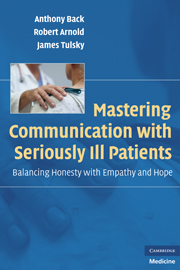Book contents
- Frontmatter
- Contents
- PREFACE
- 1 TAKING YOUR SKILLS TO THE NEXT LEVEL
- 2 GETTING A GOOD START
- 3 TALKING ABOUT SERIOUS NEWS
- 4 DISCUSSING EVIDENCE FOR MAKING TREATMENT DECISIONS
- 5 DISCUSSING PROGNOSIS
- 6 BETWEEN THE BIG EVENTS
- 7 CONDUCTING A FAMILY CONFERENCE
- 8 DEALING WITH CONFLICTS
- 9 TRANSITIONS TO END-OF-LIFE CARE
- 10 TALKING ABOUT DYING
- 11 CULTIVATING YOUR SKILLS
- APPENDIX A THE ROADMAPS IN OUTLINE FORM
- APPENDIX B ACKNOWLEDGMENTS
- INDEX
4 - DISCUSSING EVIDENCE FOR MAKING TREATMENT DECISIONS
“How would you like to be involved in this decision?”
Published online by Cambridge University Press: 23 November 2009
- Frontmatter
- Contents
- PREFACE
- 1 TAKING YOUR SKILLS TO THE NEXT LEVEL
- 2 GETTING A GOOD START
- 3 TALKING ABOUT SERIOUS NEWS
- 4 DISCUSSING EVIDENCE FOR MAKING TREATMENT DECISIONS
- 5 DISCUSSING PROGNOSIS
- 6 BETWEEN THE BIG EVENTS
- 7 CONDUCTING A FAMILY CONFERENCE
- 8 DEALING WITH CONFLICTS
- 9 TRANSITIONS TO END-OF-LIFE CARE
- 10 TALKING ABOUT DYING
- 11 CULTIVATING YOUR SKILLS
- APPENDIX A THE ROADMAPS IN OUTLINE FORM
- APPENDIX B ACKNOWLEDGMENTS
- INDEX
Summary
After delivering serious medical news, the next communication task is often to address treatment options. In discussing decision making, a physician must summarize a body of biomedical evidence, present choices to the patient, understand the patient's perspective, and finally come to a decision about which option to pursue. This multifaceted process is complex and, in its totality, goes beyond the scope of this book. Yet one thing is clear: discussing treatment options is much more than simply giving information. Many recommendations about discussing treatments seem to assume that physicians dispense information like a drug, and that more is always better. While information is important, and patients do wish to be informed, offering more information alone is too simplistic a guide for physicians helping patients with difficult decisions.
In this chapter, we discuss how to communicate evidence that should bear on the treatment decision, and how to talk about, or frame, the decision-making process. Our approach is based on studies that have examined how patients feel about information, how they absorb information, and how they want to make medical decisions. Although we do not intend here to present a comprehensive treatment of decision making, we do offer several clear communication tools that, we hope, will make the decision-making process easier for you and your patients.
- Type
- Chapter
- Information
- Mastering Communication with Seriously Ill PatientsBalancing Honesty with Empathy and Hope, pp. 39 - 48Publisher: Cambridge University PressPrint publication year: 2009



